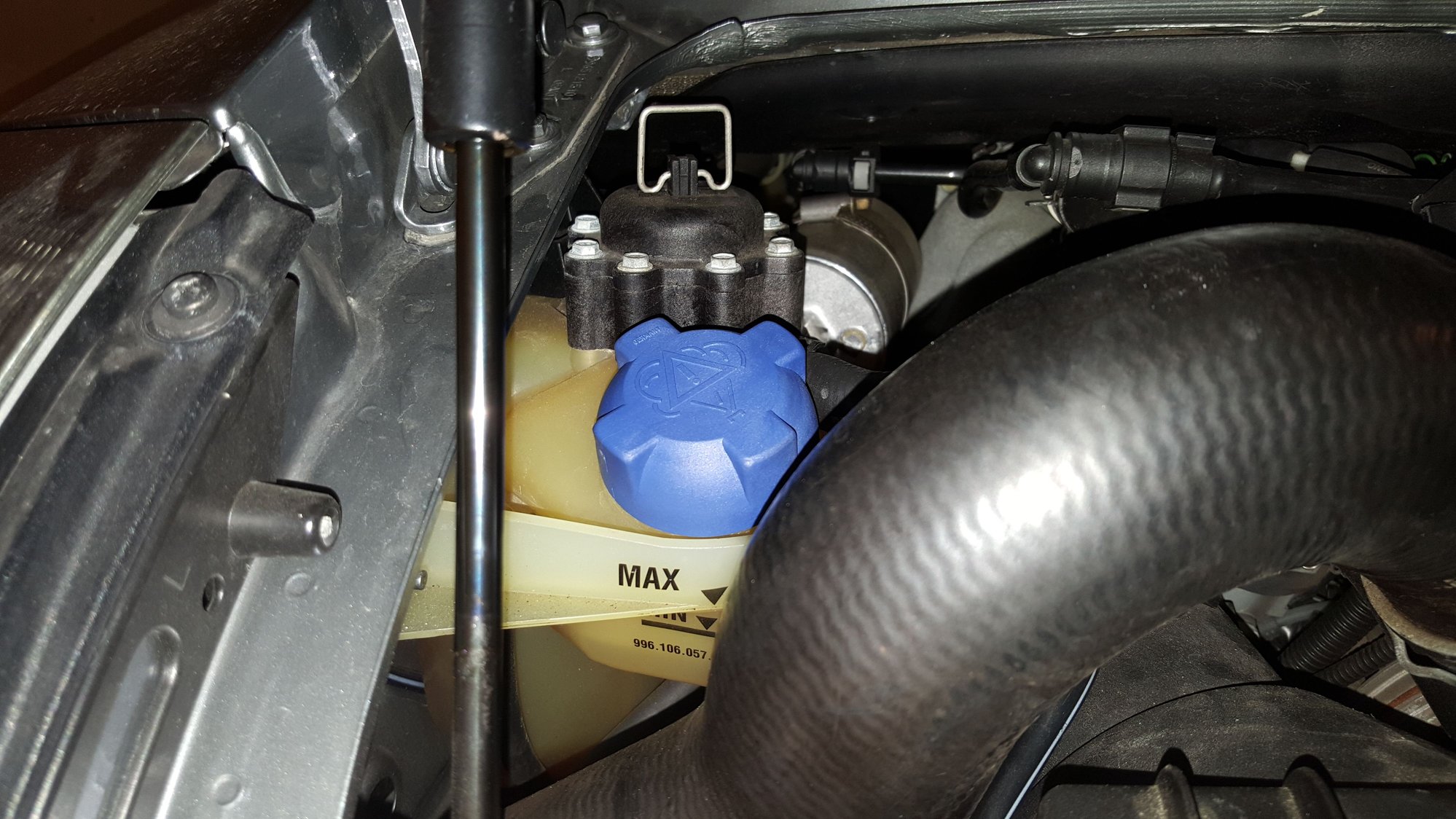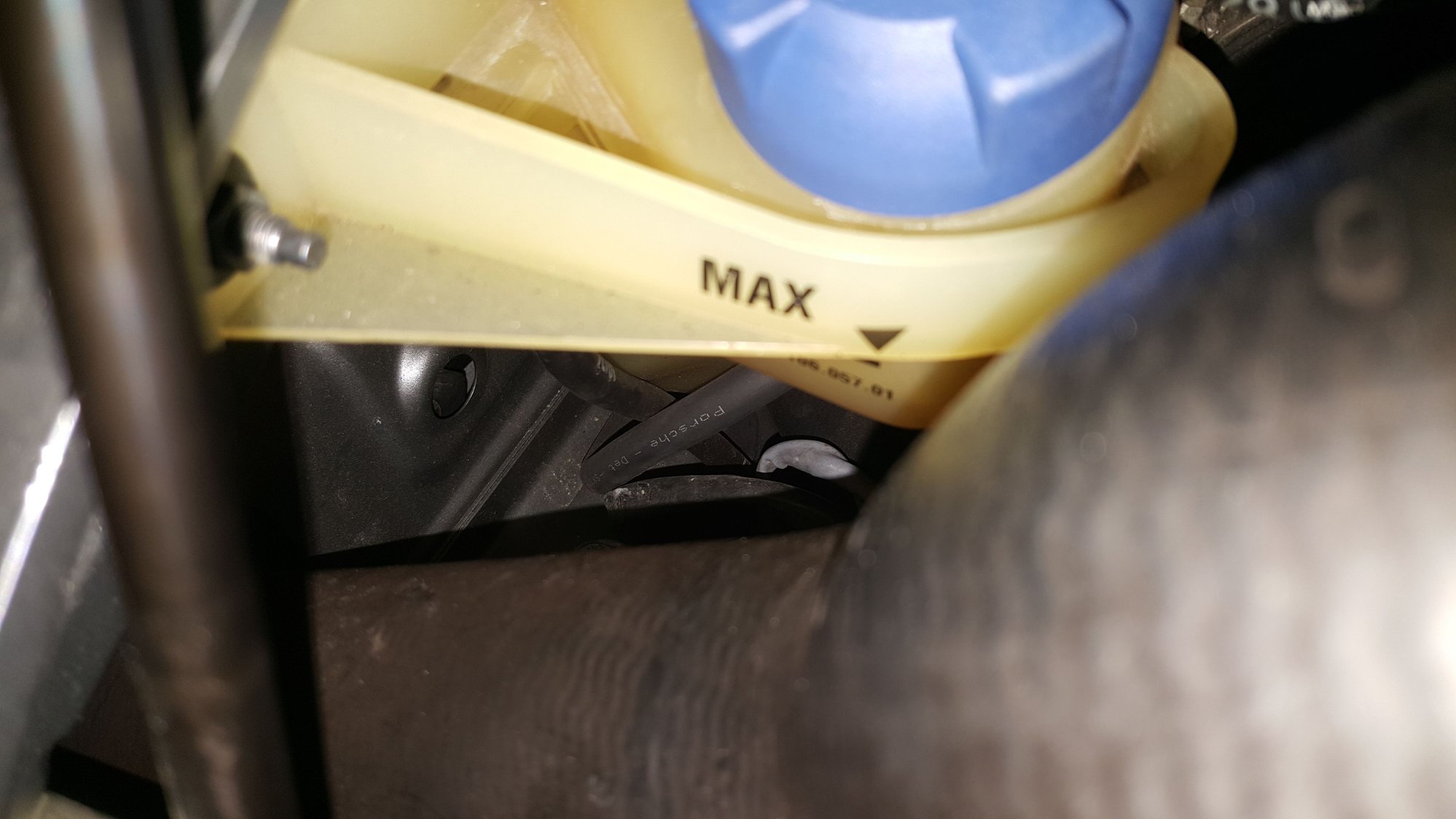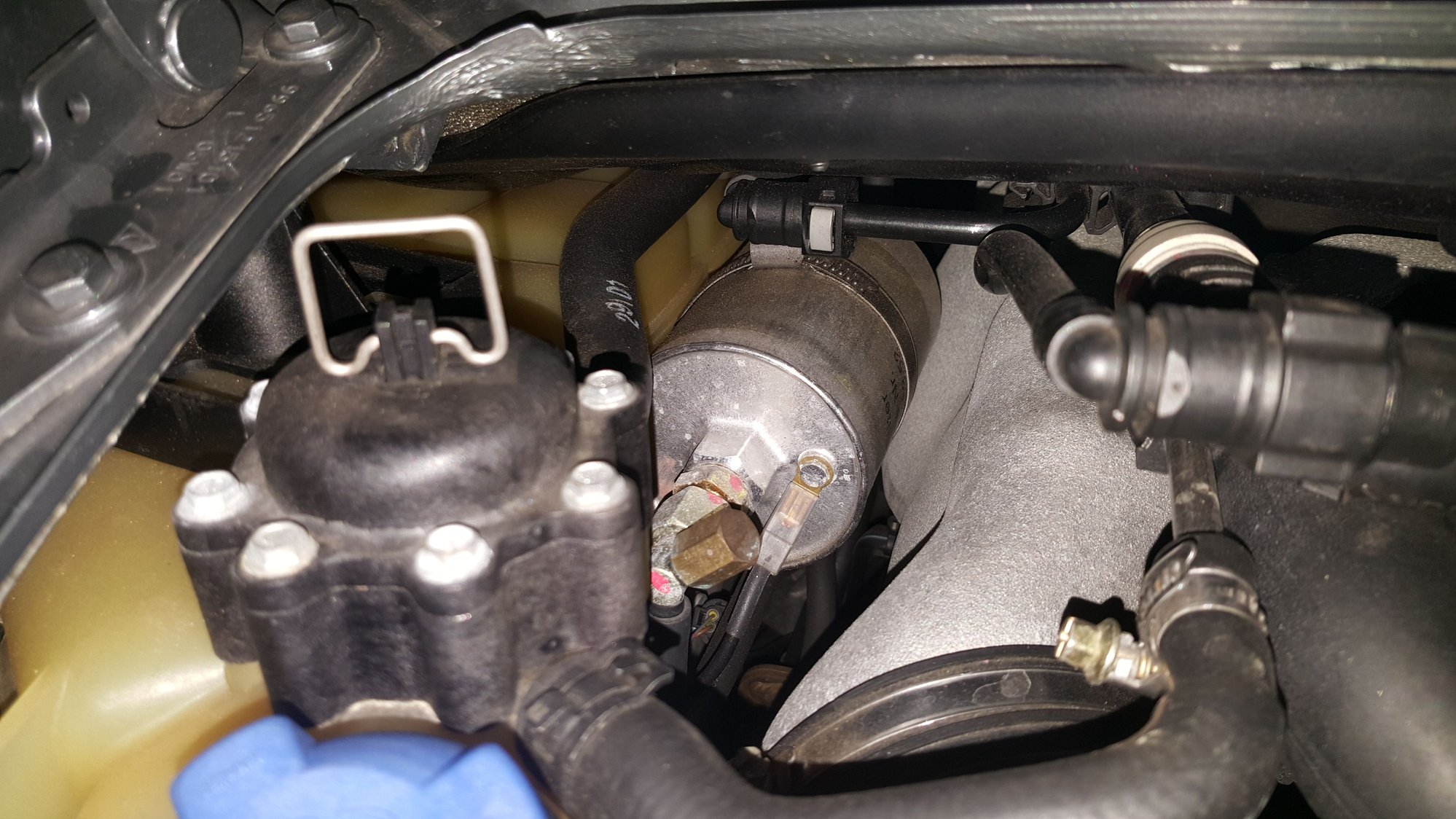Burning smell and coolant?
#1

So yesterday I just got the car back from the indy P car shop. For those who have been following, 2002 996tt got new OEM engine/tranny mounts, new water pump w/flush & bleed of coolant & new Porsche coolant, new serpentine belt (last one done only 1 year ago, but was found to be worn), and new coolant reservoir cap that was found to be cracked.
My main complaints to the tech was:
1) Rough/incomplete shifting form N-2 and 2-3 which I believe has been rectified due to the mounts. So this part is good.
2) Strange burning odor coming from the engine bay after driving the car. Tech initially suspected may be due to cracked coolant cap when they were replacing the water pump.
I didn't concentrate much yesterday about the smell when I picked up the car b/c my main thing was the shifting issues.
But today after driving the car for ~20-25min wife noticed a burning smell after I parked the car outside. Then drove home, parked it inside the garage, and we noticed the same burning smell.
So I took a pic of the engine and posted it above. No obvious white residue (coolant) I can see. How is it possible that the car is low on coolant 1 day later, esp after the shop flushed and added new coolant? I didn't bother to check the coolant level when I picked up the car, in hindsight I should have.
And what about that smell? Is the burning smell burnt coolant? Are the smell and low coolant level related? The shop is closed today since it's a Sat; I'll call them on Mon. But as now, a little weary here...
#2
My 996tt had a front radiator leak that I could've sworn smelled like burning coolant. It was just plain ol' coolant and wasn't leaking enough to leave a puddle. You may want to pull your front bumper and have a look... you can't see it easily otherwise.
GL
GL
#3
Just a guess...
If you had a cracked res cap, it was a "weak link" in a pressurized system (perhaps the weakest link). Now that the cap has been replaced, the pressurized system is now exposing other weak links.
If you had a cracked res cap, it was a "weak link" in a pressurized system (perhaps the weakest link). Now that the cap has been replaced, the pressurized system is now exposing other weak links.
#4
Your expansion tank is very yellow which usually indicates brittle plastic. I would not doubt that your tank is cracked. It usually cracks on the side away from the engine. Look at the "frame" & exhaust under the tank for signs of a leak.
I would think this would be more likely to happen/get worse after the cracked cap was replaced with a new one that holds the correct, higher, pressure.
Your picture shows that the engine was still warm by the fact that the vacuum relief, bleeder, valve is still up. If you flip the metal bale up until the engine is cold it will help to bleed any air pockets that may have been trapped in your system. You can drive around with the bale up for a couple days to make sure the system is bled.
You can also bleed it by getting the rear up a couple feet in the air remove the cap(when the engine is cold!) and run it until it is warm while monitoring/adding coolant if needed.
I would think this would be more likely to happen/get worse after the cracked cap was replaced with a new one that holds the correct, higher, pressure.
Your picture shows that the engine was still warm by the fact that the vacuum relief, bleeder, valve is still up. If you flip the metal bale up until the engine is cold it will help to bleed any air pockets that may have been trapped in your system. You can drive around with the bale up for a couple days to make sure the system is bled.
You can also bleed it by getting the rear up a couple feet in the air remove the cap(when the engine is cold!) and run it until it is warm while monitoring/adding coolant if needed.
#5
Your expansion tank is very yellow which usually indicates brittle plastic. I would not doubt that your tank is cracked. It usually cracks on the side away from the engine. Look at the "frame" & exhaust under the tank for signs of a leak.
I would think this would be more likely to happen/get worse after the cracked cap was replaced with a new one that holds the correct, higher, pressure.
Your picture shows that the engine was still warm by the fact that the vacuum relief, bleeder, valve is still up. If you flip the metal bale up until the engine is cold it will help to bleed any air pockets that may have been trapped in your system. You can drive around with the bale up for a couple days to make sure the system is bled.
You can also bleed it by getting the rear up a couple feet in the air remove the cap(when the engine is cold!) and run it until it is warm while monitoring/adding coolant if needed.
I would think this would be more likely to happen/get worse after the cracked cap was replaced with a new one that holds the correct, higher, pressure.
Your picture shows that the engine was still warm by the fact that the vacuum relief, bleeder, valve is still up. If you flip the metal bale up until the engine is cold it will help to bleed any air pockets that may have been trapped in your system. You can drive around with the bale up for a couple days to make sure the system is bled.
You can also bleed it by getting the rear up a couple feet in the air remove the cap(when the engine is cold!) and run it until it is warm while monitoring/adding coolant if needed.

Is that the pressure relief valve you are referring to?
I just saw your post, so the engine is now cool when I pulled up the prv. Should I continue to drive the car around with the pr valve "up?" Or should I put it back down?
I checked around the engine and underneath the car as best as I can (I don't have a lift). No white residue. No white residue at the radiators either, and no smell coming from the front, only the rear.
I have premixed Prestone coolant. Should I add some coolant? Or should I leave the coolant level as is to show the tech when Monday comes around?
Is it wise to continue driving the car?
Getting a little frustrated here. I asked the tech to check if the coolant reservoir needs to be replaced at time of water pump replacement; he said the reservoir was fine, only a cracked coolant cap.
Now I will likely have to go back to the shop again to get this issue resolved. Hopefully it's something as simple as replacing the reservoir. Or maybe it's also a faulty relief valve?
#6
Going to have to agree with Th Dude. The new cap has improved the sealing of the cooling system and the higher pressure has now made another leak active.
Number one suspect has to be the coolant tank.
With the engine cold top up the coolant tank with distilled water. Do not over fill. Be sure the tank threads are clean and the cap threads likewise and be sure you install the cap without cross threading and tighten the cap down fully. These caps can require more force to get completely tight that one may at first suspect.
Take the car out and drive around on residential streets with some stop signs, stop lights, and relatively slow speeds. Don't race the engine but do use perhaps a lower gear than you might otherwise. (As a rough rule of thumb I select the gear based on the speed limit: up to 15mph I use 1st gear; in the 20's I use 2nd; in the 30's I use 3rd and so on.)
Once the coolant gage needle as been at or very near the 180 hash mark for a while and the engine and its load of fluids -- coolant as well as oil -- are up to temperature head home and in the driveway raise RPMs to say 1K or so. Hold until you hear or a helper hears the radiator fans come on. Let the engine idle a moment or two, but not so long the fans shut off, then shut off the engine.
As the engine sits its heat load will heat the coolant and raise its pressure. If the cooling system has a weak spot I think you'll know it from the signs of coolant dripping or even gushing out.
Use your nose but don't get your face too close to the engine.
If the leak isn't the coolant tank it might be one or more of the engine coolant fittings. However, these failing on a car that sees no track time is rare. Still it is a possibility. But my money, but not much though, is on the coolant tank. Far more of these fail/leak than coolant fittings.
Number one suspect has to be the coolant tank.
With the engine cold top up the coolant tank with distilled water. Do not over fill. Be sure the tank threads are clean and the cap threads likewise and be sure you install the cap without cross threading and tighten the cap down fully. These caps can require more force to get completely tight that one may at first suspect.
Take the car out and drive around on residential streets with some stop signs, stop lights, and relatively slow speeds. Don't race the engine but do use perhaps a lower gear than you might otherwise. (As a rough rule of thumb I select the gear based on the speed limit: up to 15mph I use 1st gear; in the 20's I use 2nd; in the 30's I use 3rd and so on.)
Once the coolant gage needle as been at or very near the 180 hash mark for a while and the engine and its load of fluids -- coolant as well as oil -- are up to temperature head home and in the driveway raise RPMs to say 1K or so. Hold until you hear or a helper hears the radiator fans come on. Let the engine idle a moment or two, but not so long the fans shut off, then shut off the engine.
As the engine sits its heat load will heat the coolant and raise its pressure. If the cooling system has a weak spot I think you'll know it from the signs of coolant dripping or even gushing out.
Use your nose but don't get your face too close to the engine.
If the leak isn't the coolant tank it might be one or more of the engine coolant fittings. However, these failing on a car that sees no track time is rare. Still it is a possibility. But my money, but not much though, is on the coolant tank. Far more of these fail/leak than coolant fittings.
Last edited by Macster; 02-28-2016 at 02:08 PM. Reason: Fxied typoes.
#7

Is that the pressure relief valve you are referring to?
I just saw your post, so the engine is now cool when I pulled up the prv. Should I continue to drive the car around with the pr valve "up?" Or should I put it back down?
I checked around the engine and underneath the car as best as I can (I don't have a lift). No white residue. No white residue at the radiators either, and no smell coming from the front, only the rear.
I have premixed Prestone coolant. Should I add some coolant? Or should I leave the coolant level as is to show the tech when Monday comes around?
Is it wise to continue driving the car?
Getting a little frustrated here. I asked the tech to check if the coolant reservoir needs to be replaced at time of water pump replacement; he said the reservoir was fine, only a cracked coolant cap.
Now I will likely have to go back to the shop again to get this issue resolved. Hopefully it's something as simple as replacing the reservoir. Or maybe it's also a faulty relief valve?
Yes that is the bleeder valve that you have flipped up. It is really more of a vacuum break to allow the tank to "vent" to atmospheric pressure as the engine cools down. As you noticed it moves up when the engine gets hot but still holds pressure. As the engine cools with bale holding the valve open it allows coolant to be pulled into the system displacing air pockets. Keep the tank above min.
Trending Topics
#8


Today's weather was pretty crappy so I didn't drive the car around. But I did pull up the relief valve, started the car, and let it run idle for a few minutes. I didn't add any coolant or distilled water.
Perhaps I didn't run it long enough, but even after a few minutes idling I did smell a little burnt smell coming from the coolant reservoir. I snapped a few pics. Not sure if some of that white residue on the "circular metal soda can" or one of the rubber tubing is burnt coolant.
I'll be calling the shop tomorrow and likely bringing the car in for them to look at. Hoping I won't be without the car again this week, ugh.
#9
Don't get discouraged. I spent $10k and 6 months getting my car sorted out after I bought it sight unseen. Between a Porsche dealership performed PPI that missed a bad clutch and stuck wastegates and then my local Indy Porsche "experts" messing up my vacuum/boost hoses and adding a butchered tune, it was a long and stressful road. But, with the help from the amazing folks here, I got it sorted out and now wouldn't trade my car for any other.
#10
Soda can is the fuel filter. You need to get the car at least 180 and let it cool to do much "venting". Follow Macsters procedure for leak detection.
My tank had a small crack that resulted in an antifreeze smell and small loss of coolant for weeks until one day it opened enough to drip on the ground.
Going back to your OP, when the shop refilled the system after the water pump replace there might have been some air in the system. As the air works its way out you will have to add coolant, DO IT. Then monitor for loss.
This is what mine looked like:
My tank had a small crack that resulted in an antifreeze smell and small loss of coolant for weeks until one day it opened enough to drip on the ground.
Going back to your OP, when the shop refilled the system after the water pump replace there might have been some air in the system. As the air works its way out you will have to add coolant, DO IT. Then monitor for loss.
This is what mine looked like:
Last edited by fpb111; 02-29-2016 at 01:33 PM.
#11
I'm also wondering if there was a leak that was fixed by the shop/during the water pump replacement if any fluid spilled out onto other components/engine/etc...perhaps the smell is coming from residual fluid that leaked out being heated and burnt off. Depending on how far you've driven it, might be unlikely, but not impossible.
Good luck getting it sorted, be happy to help if you need a hand with anything before taking her back to shop.
Good luck getting it sorted, be happy to help if you need a hand with anything before taking her back to shop.
#14
Docboy,
Are you sure that your cap is correct? It is the first one that I have seen that does not have the part number on the top face. It may be one for a different model Porsche.
T10Chris, or someone, can you post a pic of your cap?
https://www.google.com/search?q=996+...JvHj9Pi5x6M%3A
Are you sure that your cap is correct? It is the first one that I have seen that does not have the part number on the top face. It may be one for a different model Porsche.
T10Chris, or someone, can you post a pic of your cap?
https://www.google.com/search?q=996+...JvHj9Pi5x6M%3A
#15
Pressure relief valve shoild be down down. I suggest after you drive the car, and smell the coolant smell, go to the front and smell at the vents, if at the front bumper vents you probably have a weeping radiator, common issue. If not in the front open the engine lid and smell around and see if you can isolate it!

